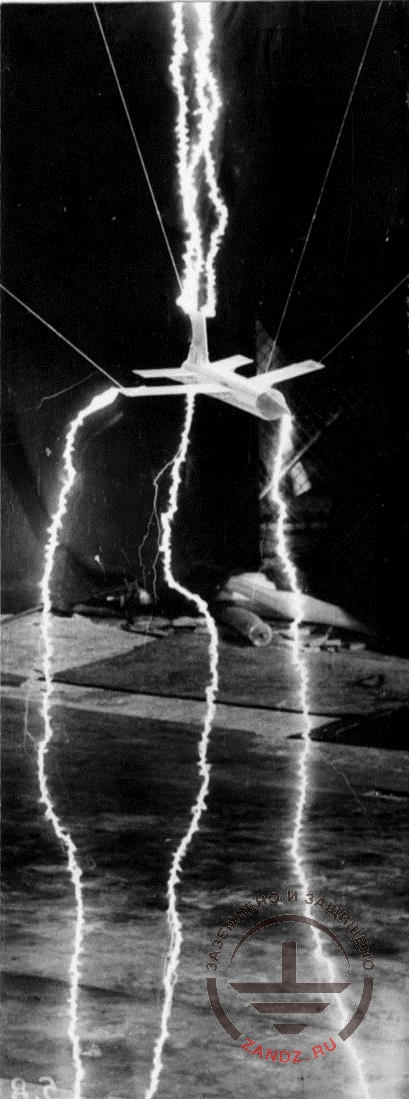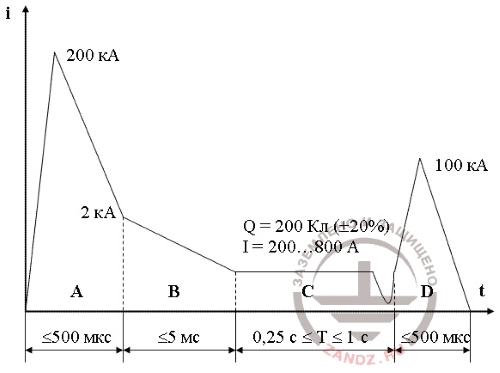The seventh part of the article "Lightning protection of aircrafts"
Determination of lightning strike points
According to the rules of the international aviation organization ICAO no aircraft can be used for passenger transportation without detailed tests for lightning resistance. Their method imitates the consequences of a direct lightning strike with ultimate parameters on an aircraft. The requirements to the test procedure are so strict, that their organization still creates problems, and the results are not always treated unambiguously.
Indeed, the main queston refers to the method of tests for the selective lightning vulnerability. They must define the places of the most probable contact of the lightning channel with the surface of the aircraft. Nothing else, except small-scale models, was created. They are placed in the discharge interval 10-15 m long and are shooting it with spark discharges, which are formed by the source of high voltage (fig. 11).

fig. 11. Laboratory tests for the selective vulnerability of an aircraft
We cannot say that the specialists trust such tests. Their results strongly depend on the model scale, on the polarity of the voltage pulse, forming the spark and even on pulse time parameters. In the best case, we can talk about quantitative estimations. The method of stand tests on the determination of places of a probable lightning start from the aircraft surface in the electric field of a thunder cloud is not much more reasonable. This time, the model is approximately one meter long and is placed into the gap between the flat electrodes with homogeneous electric field. Streamer flashes start places, noticeable on pictures (fig. 12), they are identified with the places of most probable lightning initiation.
Consequences of impact of current and electromagnetic field
On fig.13 standardized current pulse, reproducting the first and the next components of the lightning flash, and also the long current between them.

fig. 13. Lightning current standardized pulse scheme
The scheme doesn't reveal the parameters of the pulse front, and they are very important for the idea about the required parameters of high-voltage source on a test stand. So, the standardized duration of the first pulse front is taken equal to 2 ms, and its maximal steepness Ai=100 kA/ms. Now you can imagine the parameters of the source, which will be required for full-scale tests of a modern air-craft.
The steepness of the Ai current front in the loading with the L inductivity is provided at the output source voltage
 (9)
(9)
For a rough estimation, the running inductance of the conductor in microhenry can be identified with its length in meters. How can a modern air craft have Llightning current ≈ 50 mH. Substitution of this value in (9) at Ai=100 kA/ms gives U=5 MV. For this reason alone, the test installation is complex and expensive. That is why, at any possibility it is better to test not the whole airplane, but its separate fragments relative its small length. It is usually done when it is necessary to test new fuselage materials, separate mount fittings or exterior sensors for lightning resistance. The limited length of the sample allows to get along with the sources of low voltage.
Specialists of aircrafts lightning protection can rarely boast the perfect test equipment. The work is great here, and the imperfection of tests is being compensated by the stock in project calculations of constructive elements. Such a solution cannot be called very succesful. There is a proverb in aviation: "An absolutely safe airplane will have a single shortcoming - it won't take off!"
E. M. Bazelyan, DEA, professor
Energy Institute named after G.M. Krzyzanowski, Moscow
Read more "8. What do composite materials promise"
See also:
- Useful materials for grounding and lightning protection designers
- Free webinars with the leading industry experts
- Real-life examples of grounding and lightning protection calculations
Related Articles:
 Lightning protection of residential and public buildings - answers to frequently asked questions in the design
Lightning protection of residential and public buildings - answers to frequently asked questions in the design
 Lightning Protection of Large Territories: Parks, Grounds, Plant Territories. Page 1
Lightning Protection of Large Territories: Parks, Grounds, Plant Territories. Page 1
 Lightning Protection of Large Territories: Parks, Grounds, Plant Territories. Page 2
Lightning Protection of Large Territories: Parks, Grounds, Plant Territories. Page 2
 Lightning Protection of Large Territories: Parks, Grounds, Plant Territories. Page 3
Lightning Protection of Large Territories: Parks, Grounds, Plant Territories. Page 3

